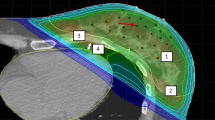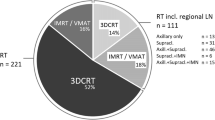Abstract
Background and purpose
To compare dosimetrically the radiation exposure to heart, left ventricle (LV), and left anterior descending artery (LAD) between whole-breast radiotherapy (WBRT) with Active Breathing Coordinator (ABC; ABC-WBRT) and interstitial multicatheter high-dose-rate (HDR) brachytherapy as accelerated partial breast irradiation (ABPI; imHDR-APBI) for left-sided breast cancer (BCA) after breast-conserving surgery (BCS).
Materials and methods
Between January 2016 and December 2019, 32 and 20 patients were treated with ABC-WBRT (63 Gy/2.25 Gy) and imHDR-APBI (32 Gy/4 Gy), respectively. Among them a matched-pair analysis was performed according to tumor location (clock position) before BCS as well as planning target volume of imHDR-APBI and boost volume of ABC-WBRT. This yielded 17 pairs of patients for whom dosimetric parameters for heart, LV, and LAD were evaluated. The Mann–Whitney test was used for comparison after adjusting for equivalent dose in 2‑Gy fractions (EQD2). In addition, a second analysis of ABC-WBRT to 40.05 Gy in 15 fractions was performed in order to account for the EQD2 difference between the 63-Gy ABC-WBRT and the imHDR-APBI protocol.
Results
Tumor location for the 17 pairs of patients relative to breast quadrant was as follows: upper outer 8, lower outer 5, upper inner 3, and lower inner 1. There was no difference regarding mean heart dose (MHD) and V5, whereas D25%, D45%, V10, and V25 significantly favored imHDR-APBI. Likewise, mean dose- and V5-LV did not differ, while Dmax- and V23-LV were significantly higher for ABC-WBRT. For LAD, Dmax, D25%, and V30 significantly favored imHDR-APBI without differences for mean dose and V40. When comparing imHDR-APBI with the 40.05 Gy ABC-WBRT schedule, MHD and mean dose LV were significantly lower in favor of ABC-WBRT.
Conclusion
ABC-WBRT and imHDR-APBI yield similar low heart and LV exposure for left-sided BCA after BCS, whereas LAD can be better spared with imHDR-APBI.


Similar content being viewed by others
References
Darby S, McGale P, Correa C et al (2011) Effect of radiotherapy after breast-conserving surgery on 10-year recurrence and 15-year breast cancer death: meta-analysis of individual patient data for 10,801 women in 17 randomised trials. Lancet 378:1707–1716
Roychoudhuri R, Robinson D, Putcha V et al (2007) Increased cardiovascular mortality more than fifteen years after radiotherapy for breast cancer: a population-based study. BMC Cancer 7:9
Taylor CW, Nisbet A, McGale P et al (2007) Cardiac exposures in breast cancer radiotherapy: 1950s-1990s. Int J Radiat Oncol Biol Phys 69:1484–1495
Taylor CW, Wang Z, Macaulay E et al (2015) Exposure of the heart in breast cancer radiation therapy: a systematic review of heart doses published during 2003 to 2013. Int J Radiat Oncol Biol Phys 93:845–853
Darby SC, Ewertz M, McGale P et al (2013) Risk of ischemic heart disease in women after radiotherapy for breast cancer. N Engl J Med 368:987–998
Duma M, Baumann R, Budach W et al (2019) Heart-sparing radiotherapy techniques in breast cancer patients: a recommendation of the breast cancer expert panel of the German society of radiation oncology (DEGRO). Strahlenther Onkol 195:861–871
Bergom C, Currey A, Desai N et al (2018) Deep inspiration breath hold: techniques and advantages for cardiac sparing during breast cancer irradiation. Front Oncol 8:87
Boda-Heggemann J, Knopf A, Simeonova-Chergou A et al (2016) Deep inspiration breath hold-based radiation therapy: a clinical review. Int J Radiat Oncol Biol Phys 94:478–492
Strnad V, Ott OJ, Hildebrandt G et al (2016) 5‑year results of accelerated partial breast irradiation using sole interstitial multicatheter brachytherapy versus whole-breast irradiation with boost after breast-conserving surgery for low-risk invasive and in-situ carcinoma of the female breast: a randomised, phase 3, non-inferiority trial. Lancet 387:229–238
Witt JS, Gao RW, Sudmeier LJ et al (2019) Low cardiac and left anterior descending coronary artery dose achieved with left-sided multicatheter interstitial-accelerated partial breast irradiation. Brachytherapy 18:50–56
Lettmaier S, Kreppner S, Lotter M et al (2011) Radiation exposure of the heart, lung and skin by radiation therapy for breast cancer: a dosimetric comparison between partial breast irradiation using multicatheter brachytherapy and whole breast teletherapy. Radiother Oncol 100:189–194
Chan TY, Tan PW, Tan CW et al (2015) Assessing radiation exposure of the left anterior descending artery, heart and lung in patients with left breast cancer: a dosimetric comparison between multicatheter accelerated partial breast irradiation and whole breast external beam radiotherapy. Radiother Oncol 117:459–466
Major T, Stelczer G, Pesznyák C et al (2017) Multicatheter interstitial brachytherapy versus intensity modulated external beam therapy for accelerated partial breast irradiation: a comparative treatment planning study with respect to dosimetry of organs at risk. Radiother Oncol 122:17–23
Feng M, Moran JM, Koelling T et al (2011) Development and validation of a heart atlas to study cardiac exposure to radiation following treatment for breast cancer. Int J Radiat Oncol Biol Phys 79:10–18
Lee J, Hua K, Hsu S et al (2017) Development of delineation for the left anterior descending coronary artery region in left breast cancer radiotherapy: an optimized organ at risk. Radiother Oncol 122:423–430
Strnad V, Hannoun-Levi J, Guinot J et al (2015) Recommendations from GEC ESTRO breast cancer working group (I): target definition and target delineation for accelerated or boost partial breast irradiation using multicatheter interstitial brachytherapy after breast conserving closed cavity surgery. Radiother Oncol 115:342–348
Major T, Gutiérrez C, Guix B et al (2016) Recommendations from GEC ESTRO breast cancer working group (II): target definition and target delineation for accelerated or boost partial breast irradiation using multicatheter interstitial brachytherapy after breast conserving open cavity surgery. Radiother Oncol 118:199–204
Strnad V, Major T, Polgar C et al (2018) ESTRO-ACROP guideline: interstitial multi-catheter breast brachytherapy as accelerated partial breast irradiation alone or as boost—GEC-ESTRO breast cancer working group practical recommendations. Radiother Oncol 128:411–420
Strnad V, Krug D, Sedlmayer F et al (2020) DEGRO practical guideline for partial-breast irradiation. Strahlenther Onkol. https://doi.org/10.1007/s00066-020-01613-z
Landberg T, Chavaudra J, Dobbs J et al (1993) Report 50. J ICRU. https://doi.org/10.1093/jicru/os26.1.Report50
NN (2010) Report 83. J ICRU. https://doi.org/10.1093/jicru/10.1.Report83
Gagliardi G, Constine LS, Moiseenko V et al (2010) Radiation dose-volume effects in the heart. Int J Radiat Oncol Biol Phys 76:S77–S85
Piroth MD, Baumann R, Budach W et al (2019) Heart toxicity from breast cancer radiotherapy: current findings, assessment, and prevention. Strahlenther Onkol 195:1–12
Sakka M, Kunzelmann L, Metzger M et al (2017) Cardiac dose-sparing effects of deep-inspiration breath-hold in left breast irradiation: Is IMRT more beneficial than VMAT? Strahlenther Onkol 193:800–811
van Leeuwen CM, Oei AL, Crezee J et al (2018) The alfa and beta of tumours: a review of parameters of the linear-quadratic model, derived from clinical radiotherapy studies. Radiat Oncol 13:96
Jacobse JN, Duane FK, Boekel NB et al (2019) Radiation dose-response for risk of myocardial infarction in breast cancer survivors. Int J Radiat Oncol Biol Phys 103:595–604
Henson KE, McGale P, Darby SC et al (2020) Cardiac mortality after radiotherapy, chemotherapy and endocrine therapy for breast cancer: cohort study of 2 million women from 57 cancer registries in 22 countries. Int J Cancer. https://doi.org/10.1002/ijc.32908
Taylor C, McGale P, Brønnum D et al (2018) Cardiac structure injury after radiotherapy for breast cancer: cross-sectional study with individual patient data. J Clin Oncol 36:2288–2296
Taylor CW, Nisbet A, McGale P et al (2009) Cardiac doses from Swedish breast cancer radiotherapy since the 1950s. Radiother Oncol 90:127–135
Eldredge-Hindy H, Lockamy V, Crawford A et al (2015) Active breathing coordinator reduces radiation dose to the heart and preserves local control in patients with left breast cancer: report of a prospective trial. Pract Radiat Oncol 5:4–10
Holliday EB, Kirsner SM, Thames HD et al (2017) Lower mean heart dose with deep inspiration breath hold-whole breast irradiation compared with brachytherapy-based accelerated partial breast irradiation for women with left-sided tumors. Pract Radiat Oncol 7:80–85
Wennstig A, Garmo H, Isacsson U et al (2019) The relationship between radiation doses to coronary arteries and location of coronary stenosis requiring intervention in breast cancer survivors. Radiat Oncol 14(1):40
Author information
Authors and Affiliations
Corresponding author
Ethics declarations
Conflict of interest
G. Chatzikonstantinou, C. Scherf, J. Köhn, H. Ackermann, U. Ramm, and N. Tselis declare that they have no competing interests.
Additional information
Data sharing
Research data are stored by the corresponding author and will be shared upon request.
Rights and permissions
About this article
Cite this article
Chatzikonstantinou, G., Scherf, C., Köhn, J. et al. Matched-pair dosimetric comparison of cardiac radiation exposure between deep-inspiration breath-hold whole-breast radiation therapy with Active Breathing Coordinator and interstitial multicatheter high-dose-rate brachytherapy as accelerated partial breast irradiation in adjuvant treatment of left-sided breast cancer after breast-conserving surgery. Strahlenther Onkol 197, 308–316 (2021). https://doi.org/10.1007/s00066-020-01702-z
Received:
Accepted:
Published:
Issue Date:
DOI: https://doi.org/10.1007/s00066-020-01702-z




